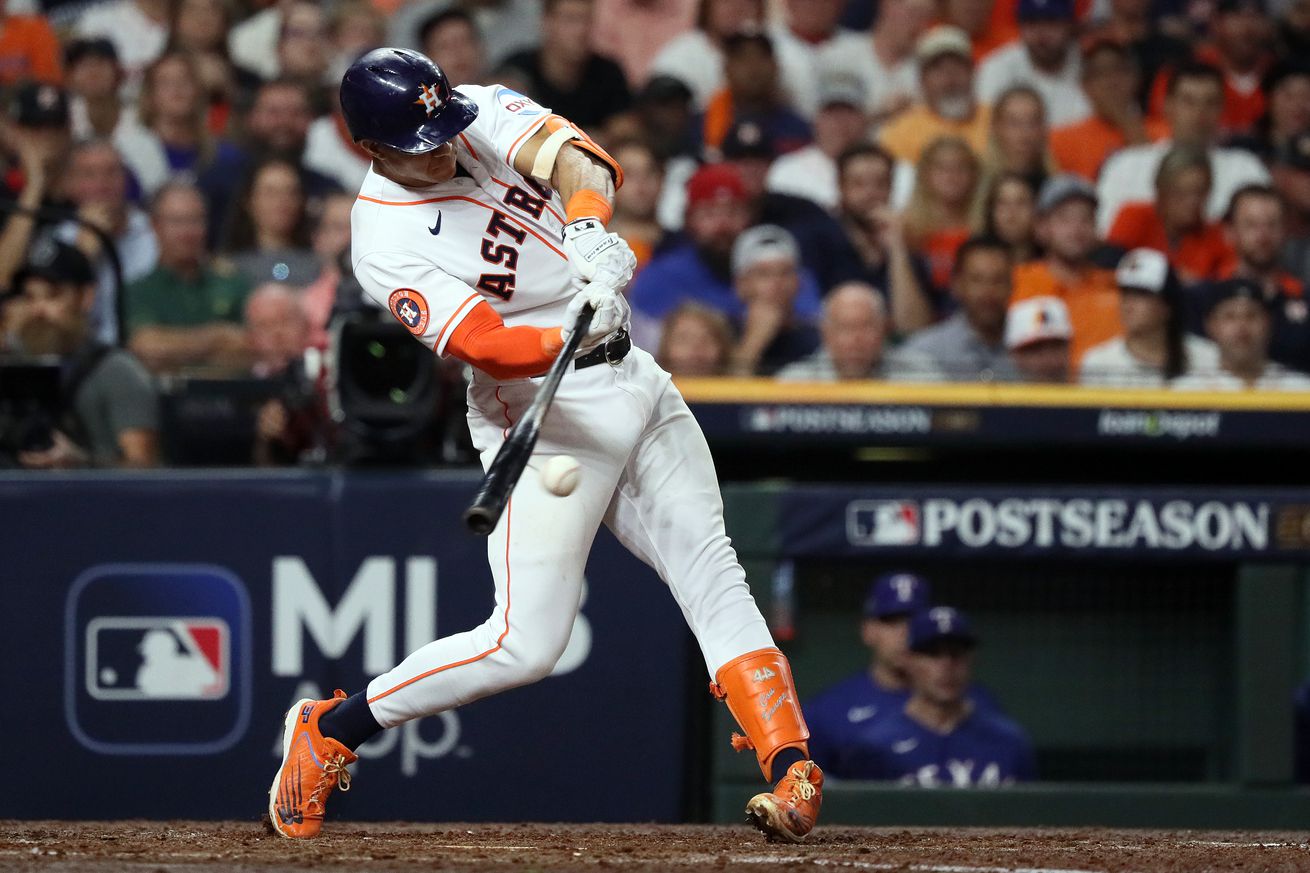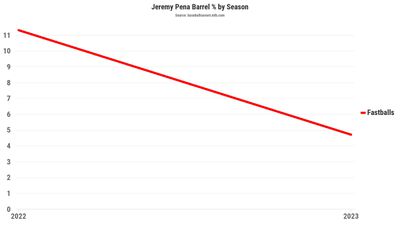
The noticeable lack of power in the second half of 2023 stands out.
Jeremy Peña’s rookie season was a resounding success, although a bit irregular at times. Even accounting for his summer slump, a 3.4-win season from their primary shortstop was a nice gain for the Astros, who decided to let Carlos Correa walk away in free agency. Peña’s leg kick adjustment in September 2022 became a much-discussed item in particular as Houston eventually won their second World Series title, with his contributions at the plate and in the field landing him both ALCS and World Series MVP honors.
It was obvious last offseason that the expectations for Peña were set high for 2023. After all, for as good as Peña was to start his career and finish his first season, there was room for more improvement. How would his adjustments at the plate carry over into 2023? Would he solidify his standing as a top-of-the-order option? Or would he regress offensively? How about his defense without the shift? There were a lot of questions surrounding Peña and whether he had real staying power as a starting shortstop.
The reason why I stated staying power as a starting shortstop is due to one reason: Peña’s strong defensive profile compared to the questions at the plate. There is little doubt that the 26-year-old can field well at the position, with or without the shift. Defensive metrics may vary on a season-by-season basis, but the numbers do generally back up Peña’s defensive reputation. For example, DRS thought higher of Peña in 2022 with a plus-16 run reading, compared to UZR with -6.3 runs. In 2023, DRS trended down to seven runs compared to UZR improving to a positive 1.2 runs. OAA (Outs Above Average) has attributed seven outs above average to Peña since 2022. While he may not grade out as the best defensive shortstop in baseball, there is little doubt that he is generally above average in the field.
The main doubt with Peña has always resided at the plate and for good reason. While his power became apparent during his debut season — 22 home runs in 558 plate appearances — there was the nagging issue of whether breaking and offspeed pitches could derail any progression as a hitter. I mean, with his defensive profile, he doesn’t have to hit much more than the league average (100 wRC+ or higher) to become extremely valuable. We saw that much in 2022 when he finished with a 102 wRC+. But he punished enough fastballs and mistake pitches to help cover those pitch recognition issues. But that famous leg kick adjustment, for example, was a terrific counter to address Peña’s issues with breaking pitches, allowing more time for pitch recognition and enabling better decisions.
However, as the 2023 season unfolded, it became increasingly clear that something wasn’t clicking for Peña at the plate. Below are his month-by-month slugging percentages. That June through July period was particularly difficult to watch.
- Mar/Apr: .464
- May: .411
- Jun: .303
- Jul: .269
- Aug: .455
- Sept/Oct: .346
Peña’s performance against fastballs took a noticeable dive compared to the previous season, specifically from a power perspective. Even putting aside the flaws of the metric for a moment, Peña had a higher batting average against fastballs in 2023, increasing from .283 to .304. One would think at first glance that this was a positive development, right? But he was simply not barreling the ball at the same rate as he did in 2022, which is one reason why his power production simply plummeted.

The same thought applies to breaking pitches, too, as Peña’s slugging percentage decreased by .156. Interestingly enough, his final wRC+ (96) wasn’t far off from his 2022 performance. But this drop-off was likely mitigated due to improved plate discipline, as his walk and strikeout rates improved. Again, a positive development, right? Normally, yes. But under Peña’s circumstances, those gains were essentially nullified by the sudden lack of barrels on balls. In turn, his power numbers — slugging percentage, isolated power — took a plunge.
Essentially, Peña took a weakness and made it less of one. In the process, however, he took a strength and turned into a near non-factor. I mean, his last home run in 2023 for the regular season and postseason was on July 5 against the Rockies. That was number 10. The Astros’ season didn’t conclude until October 23. That is a long time for a player with Peña’s reputation to regularly play without a home run. For context, Mauricio Dubón had six home runs from July 6 through the end of the regular season. Sure, Peña still had 18 extra-base hits — 16 doubles and two triples — but the lack of a home run threat was an issue, especially in the postseason when he essentially turned into a single hitter.
Ultimately, Peña’s staying power as a starting shortstop will likely hinge on how well his bat ages. It doesn’t take much — again, roughly league average — to keep him in the lineup regularly due to the value of his defensive capabilities. But his ceiling is an ongoing concern and directly impacted by his production as a hitter. Looking as far back as his time in the minors, we’ve always heard of some sort of adjustment in progress with Peña. From the outside looking in, it does appear Peña is constantly tinkering with his approach. I wonder if he would benefit from less tinkering. At some point, it may become too much, right? In any case, it all starts again in 2024. A crucial third season in the majors, in my opinion.